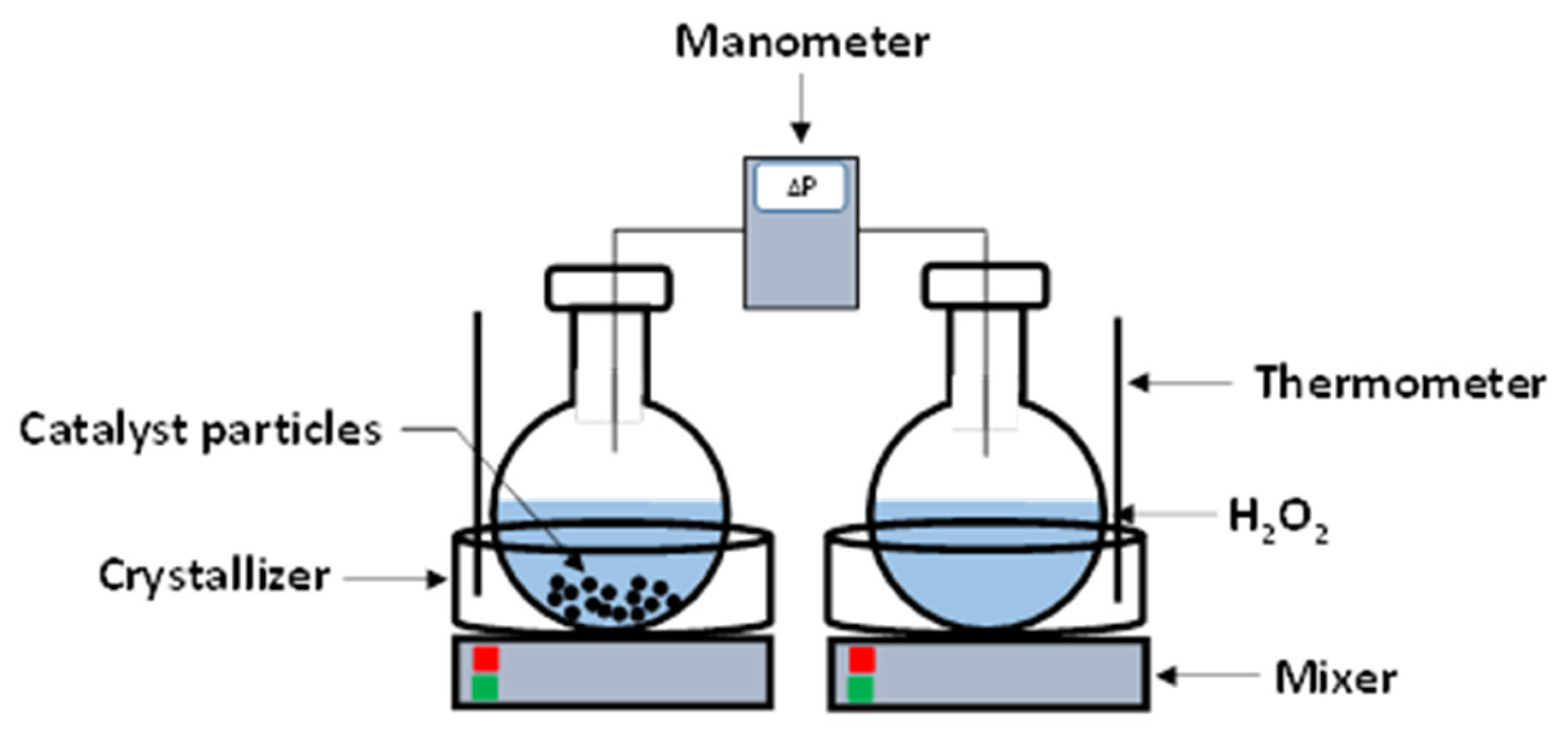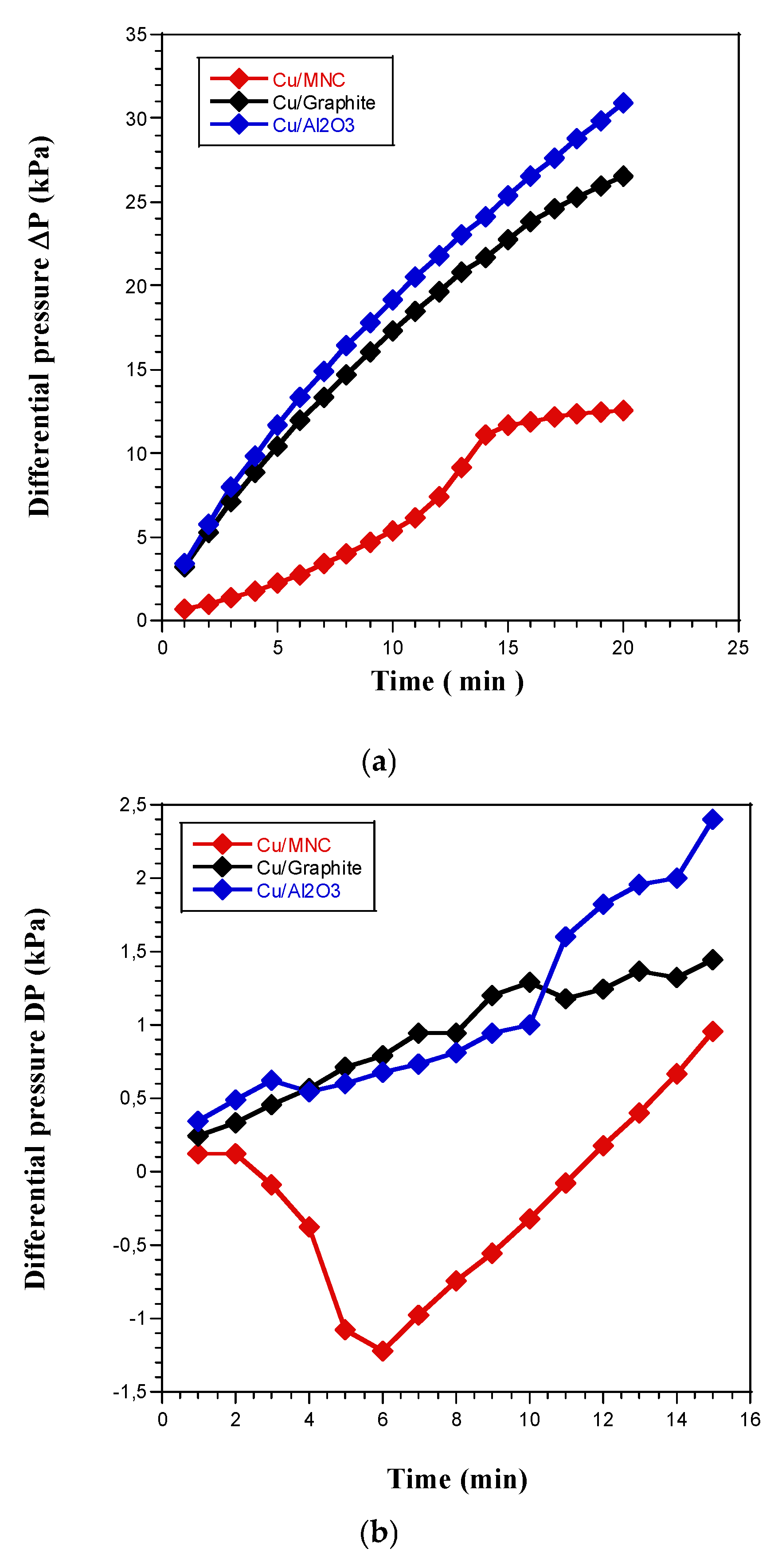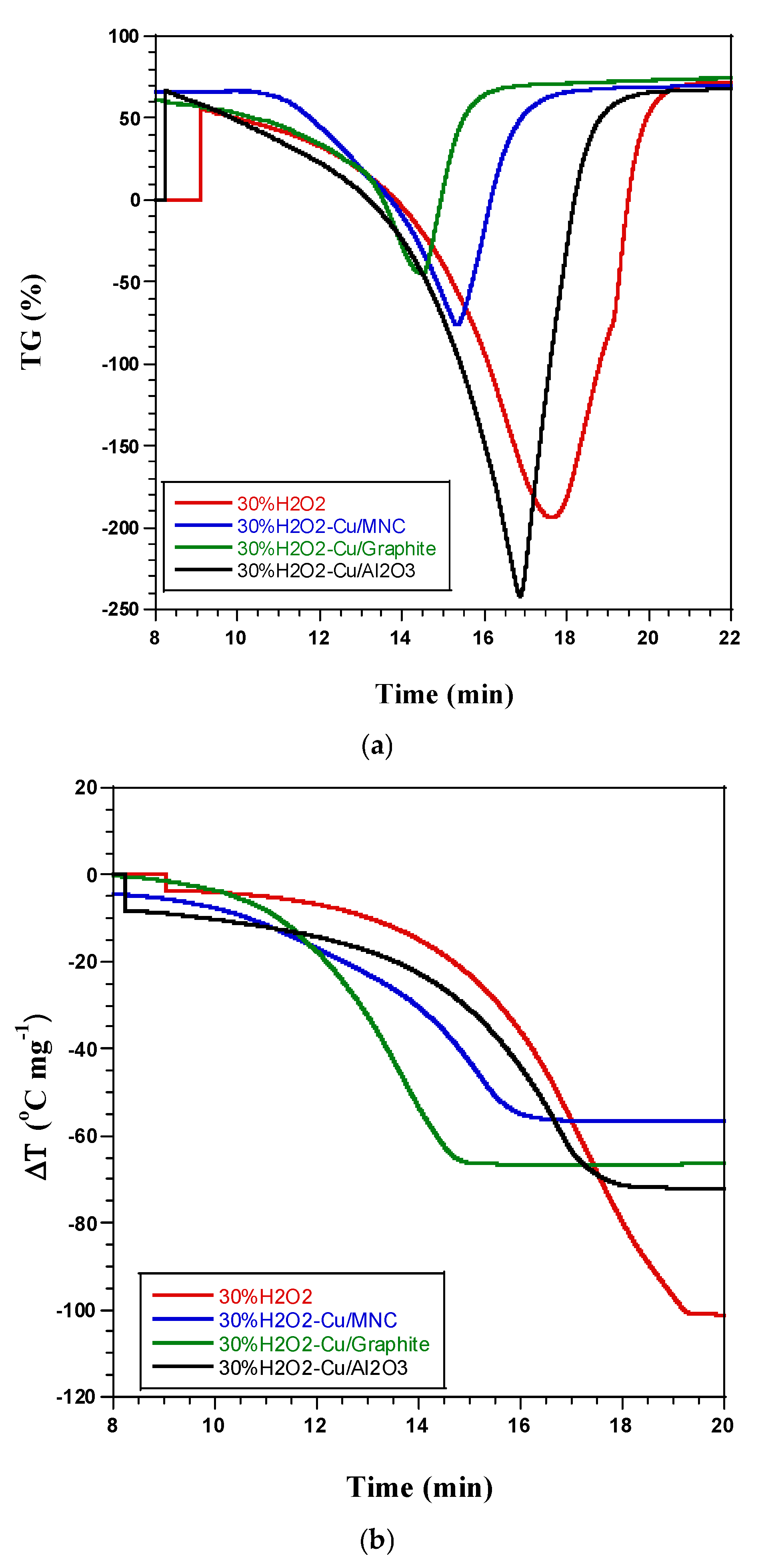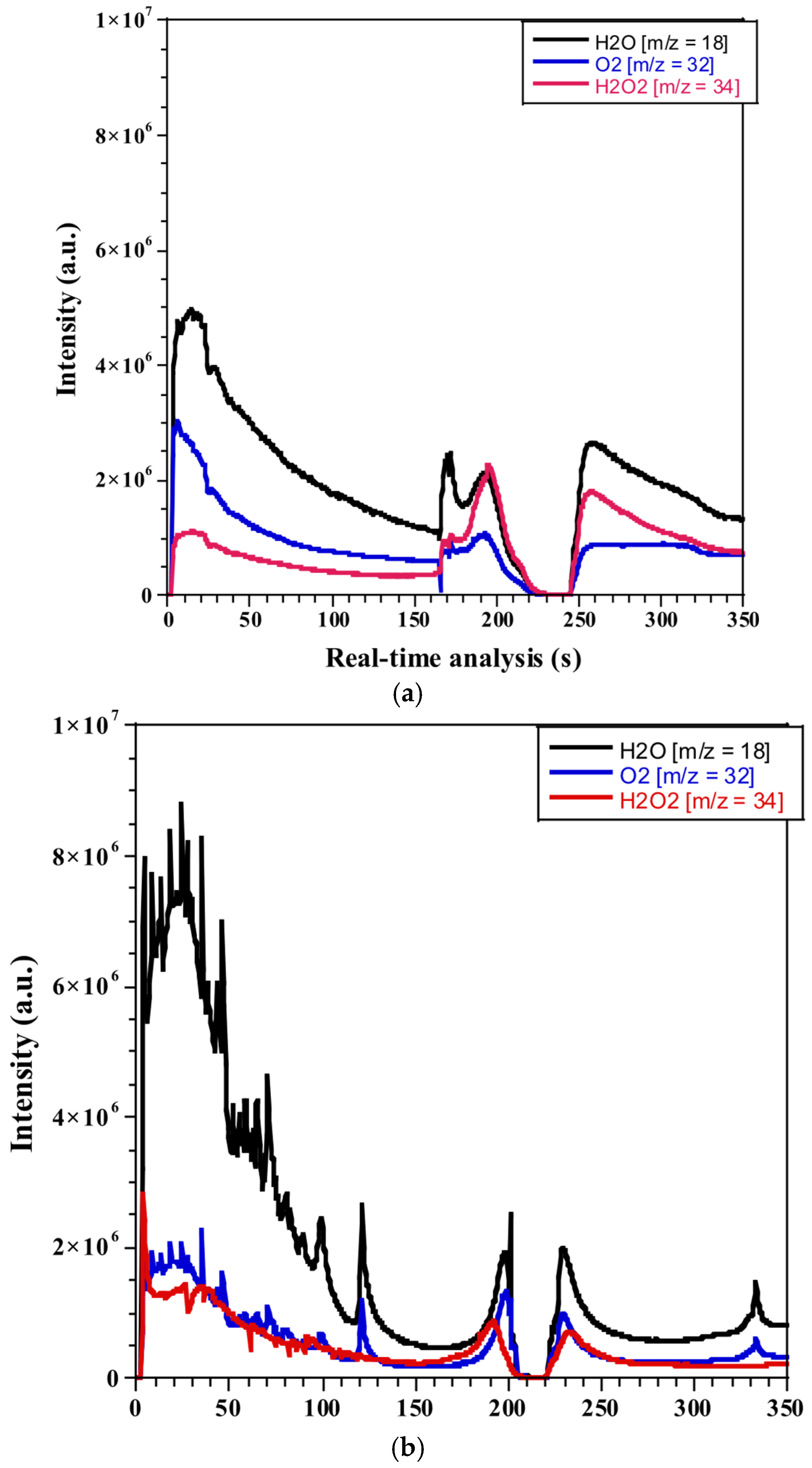Lab-Scale Thermal Decomposition of Hydrogen Peroxide as Green Propellant over Low-Cost Catalysts Based on Copper Deposited on Different Supports
Abstract
1. Introduction
2. Materials and Methods
2.1. Catalyst Preparation and Catalyst Characterization
2.2. Thermal Decomposition
2.2.1. Effective Activation Energy Tests
2.2.2. Differential Thermal Analysis–Thermogravimetric Analysis
- (i)
- Carrier gas: argon, with a flow rate of 50 mL·min−1;
- (ii)
- Heating rate: 10 °C·min−1, from room temperature up to 250 °C;
- (iii)
- The H2O2 droplet was added directly to the catalyst particles already placed in the aluminum cell.
2.2.3. Direct Insertion Probe–Mass Spectrometry
3. Results and Discussion
3.1. Thermal Decomposition
3.1.1. Effective Activation Energy Tests
3.1.2. DTA-TG Analysis
3.1.3. DIP-MS Analysis
3.2. Catalytic Characterization
4. Conclusions
Author Contributions
Funding
Data Availability Statement
Conflicts of Interest
References
- Marshall, W.M.; Deans, M.C. Recommended figures of merit for green monopropellants. In Proceedings of the 49th AIAA/ASME/SAE/ASEE Joint Propulsion Conference, San Jose, CA, USA, 14–17 July 2013. [Google Scholar]
- Final Report Summary-GRASP (Green Advanced Space Propulsion); CORDIS EU Research Results, 18 January 2013. Available online: https://cordis.europa.eu/project/id/218819/reporting (accessed on 27 February 2024).
- Gotzig, U. Challenges and Economic Benefits of Green Propellants for Satellite Propulsion. In Proceedings of the 7th European Conference for Aeronautics and Space Sciences (EUCASS), Milan, Italy, 3–6 July 2017. [Google Scholar]
- Zhu, D.L.; Law, C.K. Aerothermochemical studies of energetic liquid materials: 1. Combustion of HAN-based liquid gun propellants under atmospheric pressure. Combust. Flame 1987, 70, 333–342. [Google Scholar] [CrossRef]
- Remissa, I.; Jabri, H.; Hairch, Y.; Toshtay, K.; Atamanov, M.; Azat, S.; Amrousse, R. Propulsion Systems, Propellants, Green Propulsion Subsystems and their Applications: A Review. Eurasian Chem. J. 2023, 25, 3–19. [Google Scholar] [CrossRef]
- Nosseir, A.E.S.; Cervone, A.; Pasini, A. Review of State-of-the-Art Green Monopropellants: For Propulsion Systems Analysts and Designers. Aerospace 2021, 8, 20. [Google Scholar] [CrossRef]
- Chai, W.S.; Cheah, K.H.; Wu, M.-H.; Koh, K.S.; Sun, D.; Meng, H. A Review on Hydroxylammonium Nitrate (HAN) Decomposition Techniques for Propulsion Application. Acta Astronaut. 2022, 196, 194–214. [Google Scholar] [CrossRef]
- Ordonez Valles, L.; Blondel Canepari, L.; Apel, U.; Tajmar, M.; Pasini, A. Challenges and Opportunities of Green Propellants and Electric Pump Feeding for Future European Kick Stages. Aerotec. Missili Spaz. 2022, 101, 227–241. [Google Scholar] [CrossRef]
- Amrousse, R.; Katsumi, T.; Itouyama, N.; Azuma, N.; Kagawa, H.; Hatai, K.; Ikeda, H. New HAN-based Mixtures for Reaction Control System and Low Toxic Spacecraft Propulsion Subsystem: Thermal Decomposition and Possible Thruster Applications. Combust. Flame. 2015, 162, 2686–2692. [Google Scholar] [CrossRef]
- Amrousse, R.; Hori, K.; Fetimi, W.; Farhat, K. HAN and ADN as Liquid Ionic Mono- Propellants: Thermal and Catalytic Decomposition Processes. Appl. Catal. B 2012, 127, 121–128. [Google Scholar] [CrossRef]
- Kasbi, Y.; Remissa, I.; Toshtay, K.; Mabrouk, A.; Bachar, A.; Azat, S.; Nosseir, A.E.S.; Tiwari, A.; Sabbar, E.M.; Amrousse, R. H2O2 and HAN Green Monopropellants—A State-of-the-Art Review on Their Recent Development, Corresponding Synthesized Catalysts, and Their Possible Use as Thrusters. Catalysts 2025, 15, 183. [Google Scholar] [CrossRef]
- Amrousse, R.; Katsumi, T.; Azuma, N.; Hori, K. Hydroxylammonium Nitrate (HAN)-based Green Propellant as Alternative Energy Resource for Potential Hydrazine Substitution: From Lab Scale to Pilot Plant Scale-up. Combust. Flame 2017, 176, 334–348. [Google Scholar] [CrossRef]
- Kumar, P. An Overview on Properties, Thermal Decomposition, and Combustion Behavior of ADN and ADN based Solid Propellants. Def. Technol. 2018, 14, 661–673. [Google Scholar] [CrossRef]
- Freudenmann, D.; Ciezki, H.K. ADN and HAN-based Monopropellants—A Minireview on Compatibility and Chemical Stability in Aqueous Media. Propellants Explos. Pyrotech. 2019, 44, 1084–1089. [Google Scholar] [CrossRef]
- Gadiot, G.M.H.J.L.; Mul, J.M.; Meulenbrugge, J.J.; Korting, P.A.O.G.; Schnorkh, A.J.; Schöyer, H.F.R. New Solid Propellants Based on Energetic Binders and HNF. Acta Astronaut. 1993, 29, 771–779. [Google Scholar] [CrossRef]
- Kang, S.; Kwon, S. Preparation and Performance Evaluation of Platinum Barium Hexaaluminate Catalyst for Green Propellant Hydroxylamine Nitrate Thrusters. Materials 2021, 14, 2828. [Google Scholar] [CrossRef]
- Mansurov, Z.A.; Amrousse, R.; Hori, K.; Atamanov, M.K. Combustion/Decomposition Behavior of HAN under the Effects of Nanoporous Activated Carbon. In Innovative Energetic Materials: Properties, Combustion Performance and Application; Pang, W., DeLuca, L., Gromov, A., Cumming, A., Eds.; Springer: Singapore, 2020. [Google Scholar]
- Amrousse, R.; Katsumi, T.; Azuma, N.; Hatai, K.; Ikeda, H.; Hori, K. Development of green propellants for future space applications. Sci. Technol. Energetic Mater. 2016, 77, 105–110. [Google Scholar]
- Cassese, S.; Monteverde, F.; Gallo, G.; Mungiguerra, S.; Cecere, A.; Saraga, F.; Savino, R. Compositionally complex catalytic oxide beds free of noble metals for H2O2 fuelled monopropellant thrusters. J. Eur. Ceram. Soc. 2023, 43, 4854–4864. [Google Scholar] [CrossRef]
- Bispo, T.S.S.C.; Assunção, V.V.; Oliveira, L.R.; Alves, K.G.B.; Kulesza, J.; Barros, B.S. Synthesis and stoichiometric optimization of cobalt-manganese oxide nanocatalysts for decomposition of the green monopropellant H2O2. Ceram. Int. 2023, 49, 26635–26641. [Google Scholar] [CrossRef]
- Parzybut, A.; Surmacz, P.; Gut, Z. Impact of hydrogen peroxide concentration on manganese oxide and platinum catalyst bedperformance. Aerospace 2023, 10, 556. [Google Scholar] [CrossRef]
- Surmacz, P.; Kostecki, M.; Gut, Z.; Olszyna, A. Aluminum Oxide–Supported manganese oxide catalyst for a 98% hydrogenperoxide thruster. J. Propuls. Power 2019, 35, 614–623. [Google Scholar] [CrossRef]
- Rarata, G.; Rokicka, K. The manganese oxides decomposition catalysts for highly concentrated hydrogen peroxide. Trans. Inst. Aviat. 2015, 240, 49–57. [Google Scholar] [CrossRef]
- Jang, D.; Kang, S.; Kwon, S. Preheating characteristics of H2O2 monopropellant thruster using manganese oxide catalyst. Aerosp. Sci. Technol. 2014, 41, 24–27. [Google Scholar] [CrossRef]
- An, S.; Jin, J.; Lee, J.; Jo, S.; Park, D.; Kwon, S. Chugging Instability of H2O2 Monopropellant Thrusters with Reactor Aspect Ratio and Pressures. J. Propul. Power 2011, 27, 422–427. [Google Scholar] [CrossRef]
- Kang, S.; Lee, D.; Kwon, S. Manganese oxide lanthanum-doped alumina catalyst for application in 95 wt.% hydrogen peroxide thruster. CEAS Space J. 2020, 13, 189–196. [Google Scholar] [CrossRef]
- Srasra, E.; Bekri-Abbes, I. Bentonite Clays for Therapeutic Purposes and Biomaterial Design. Curr. Pharm. Des. 2020, 6, 642–649. [Google Scholar] [CrossRef]
- Claussen, J.C.; Daniele, M.A.; Geder, J.; Pruessner, M.; Makinen, A.J.; Melde, B.J.; Twigg, M.; Verbarg, J.M.; Medintz, I.L. Platinum-paper micromotors: An urchin-like nanohybrid catalyst for green monopropellant bubble-thrusters. ACS Appl. Mater. Interfaces 2014, 6, 17837–17847. [Google Scholar] [CrossRef]
- Harimech, Z.; Toshtay, K.; Atamanov, M.; Azat, S.; Amrousse, R. Thermal Decomposition of Ammonium Dinitramide (ADN) as Green Energy Source for Space Propulsion. Aerospace 2023, 10, 832. [Google Scholar] [CrossRef]
- McKee, D.W. Catalytic decomposition of hydrogen peroxide by metals and alloys of the platinum group. J. Catal. 1969, 14, 355–364. [Google Scholar] [CrossRef]






| Sample | Surface Area (m2 g−1) | Porous Volume (cm3 g−1) |
|---|---|---|
| γ-alumina | 160 | 0.55 |
| Cu/γ-alumina | 155 | 0.51 |
Disclaimer/Publisher’s Note: The statements, opinions and data contained in all publications are solely those of the individual author(s) and contributor(s) and not of MDPI and/or the editor(s). MDPI and/or the editor(s) disclaim responsibility for any injury to people or property resulting from any ideas, methods, instructions or products referred to in the content. |
© 2025 by the authors. Licensee MDPI, Basel, Switzerland. This article is an open access article distributed under the terms and conditions of the Creative Commons Attribution (CC BY) license (https://creativecommons.org/licenses/by/4.0/).
Share and Cite
Remissa, I.; Nosseir, A.E.S.; Tiwari, A.; Bachar, A.; Mabrouk, A.; Amrousse, R. Lab-Scale Thermal Decomposition of Hydrogen Peroxide as Green Propellant over Low-Cost Catalysts Based on Copper Deposited on Different Supports. Aerospace 2025, 12, 440. https://doi.org/10.3390/aerospace12050440
Remissa I, Nosseir AES, Tiwari A, Bachar A, Mabrouk A, Amrousse R. Lab-Scale Thermal Decomposition of Hydrogen Peroxide as Green Propellant over Low-Cost Catalysts Based on Copper Deposited on Different Supports. Aerospace. 2025; 12(5):440. https://doi.org/10.3390/aerospace12050440
Chicago/Turabian StyleRemissa, Imane, Ahmed E. S. Nosseir, Amit Tiwari, Ahmed Bachar, Assia Mabrouk, and Rachid Amrousse. 2025. "Lab-Scale Thermal Decomposition of Hydrogen Peroxide as Green Propellant over Low-Cost Catalysts Based on Copper Deposited on Different Supports" Aerospace 12, no. 5: 440. https://doi.org/10.3390/aerospace12050440
APA StyleRemissa, I., Nosseir, A. E. S., Tiwari, A., Bachar, A., Mabrouk, A., & Amrousse, R. (2025). Lab-Scale Thermal Decomposition of Hydrogen Peroxide as Green Propellant over Low-Cost Catalysts Based on Copper Deposited on Different Supports. Aerospace, 12(5), 440. https://doi.org/10.3390/aerospace12050440








